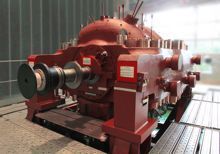SCO2 turbomachinery systems

Supercritical CO2 (sCO2) power cycles offer high efficiency and power density relative to the incumbent Steam Rankine and Air Brayton cycles for power generation over a wide range of applications, including waste heat recovery, concentrating solar power, nuclear, and fossil energy. One significant advantage of sCO2 cycles over other Brayton cycles is that the high fluid density results in very compact turbomachinery for compression and expansion. This compactness reduces material costs and is also beneficial in lowspace and potentially low-weight applications. The combinations of pressure, temperature, and density in sCO2 power cycles are outside the experience base of existing turbomachines such as gas turbines, steam turbines, and even high-pressure gas compressors, and sCO2 turbomachinery design is a significant challenge for realizing these cycles.
This article contains excerpts from the paper, "Turbomachinery overview for supercritical CO2 power cycles" at Timothy C. Allison, Jason C. Wilkes, Jeff Moore and Klaus Brun of Southwest Research Institute at the 2017 Turbomachinery Symposium.
SCO2 systems below 3 MWe and below incorporate high-speed turbines, compressors, and generators that generator operate at high speeds where power electronics are required to convert the power to grid frequency. Higher-power cases between approximately 7-50 MWe all use gearboxes between the power turbine and generator, and cases above 50 MWe have a synchronous power turbine. In most cases (where green and red circles overlap), a single turbine drives both compressors and the generator, but other layouts (with non-overlapping green and red circles) incorporate a split-shaft design with a separate higher-speed turbine to drive the compressor.
At most scales, the compressors in sCO2 turbomachinery designs are centrifugal compressors, although there is some overlap with axial compressor designs at the multi-hundred MWe scale. The distinction between pumps and compressor in sCO2 applications is not distinct since the fluid densities are high for liquid, gas, and supercritical fluid states. In all cases, the efficiency requirements and operating speeds are typically higher than grid frequencies (for < 100 MWe scales). Turbines are typically radial designs below 10 MWe and axial designs above 50 MWe, with overlapping designs in the 10-50 MWe range.
Several shaft and sealing configurations exist for transmitting shaft power between the turbomachinery and any generators/motors in an sCO2 cycle, and also between turbine(s) and compressor(s). In theory, the simplest and perhaps most elegant solution is to package all elements within the same high-pressure casing and operate the generators/motors at high pressure. This solution is compact and eliminates the need for shaft end seals and their associated leakage. In fact, this layout was applied to initial sCO2 research prototypes operated at Bettis Atomic Power Laboratory and Sandia National Laboratories. However, the high fluid density in these units has resulted in prohibitively high windage losses in the motor cavit. These machines seek to reduce the motor cavity pressure via an internal seal and scavenge pump/compressor, but the packaging of these seals inside the pressure vessel is a challenge and power consumption by the scavenge compressor significantly reduces cycle efficiency.
A hermetically-sealed machine concept also requires bearings that may be placed in the process environment (e.g. gas bearings or magnetic bearings) rather than oil-film bearings that are used on nearly all large industrial machinery. Finally, since a gearbox cannot be incorporated within the high-pressure casing, a nonsynchronous alternator speed may be required at many scales and costly power electronics are required to match grid frequency. Due to these limitations, most sCO2 machinery configurations at high power levels isolate the bearings and, potentially, gearboxes from the turbomachinery via shaft end seals.
The choice to include a gearbox depends on the scale, efficient turbomachinery speeds, and other layout options including the sealing configuration or single- or dual-shaft configurations. Epicyclic (planetary) gearboxes are typically preferred for sCO2 machines due to their smaller size and lower power consumption. Epicyclic gearboxes are available at shaft power ratings up to approximately 60 MW (GE Oil & Gas, 2016) and are often considered for coupling the turbine to a synchronous generator at 1800 or 3600 rpm. A gearbox may also be used to separate turbine and compressor speeds. Gearbox losses reduce the overall system efficiency (Beckman and Patel (2000) report gearbox losses near 1.5%), but this penalty may be eliminated by improved compressor efficiency at higher speeds.
Dual-shaft machinery layouts incorporate separate expanders for driving the compressor and generator, similar to split-shaft gas turbines. This layout enables higher-speed operation that may (depending on cycle conditions and scale) allow for more efficient compressor and possibly high-speed turbine performance. Dual-shaft layouts are also attractive for versatility during startup and shutdown since the turbine-compressor unit can be operated independently of the generator set. Disadvantages of dual-shaft turbomachinery include the requirement of a separate costly pressure casing for each of the two machines. Increasing the number of machines increases the cost of piping and ancillary equipment such as valves, lubrication oil systems, and sealing systems. In addition, the amount of CO2 lost from the system (or cost of a leakage recompression system) increases proportionally to the number of shaft end seals, which may be doubled for a dual-shaft configuration.
